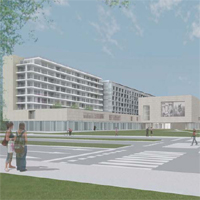The area of "Porta Vittoria” in Milan
Abstract
The transformation of Milan, to be realized completely, needs of transport infrastructure as well as major European cities. The Rail “Passante” is a trasport infrastructure almost entirely underground and it crosses the city of Milan from north-west to south-east. The "Passante" represents the structure on which to build the urban development of the "Greater Milan" and plays a strategic role in the choice of location, facilitating the creation of an urban system integrated and competitive. The "Passante" connects the central parts of the city with suburbs that are already taking advantage of the presence of the infrastructure to renew their image. The study area was originally occupied by a station of the State Railways, now is a new station of the railway "Passante". The context of urban transformation "Porta Vittoria" is located in a central area of Milan, just beyond the first “circumvallazione”, on the connecting axis the airport of Linate. The strategic location of the area, very accessible, has determined the choice of the functions that must be kept. The regeneration is characterized by two important projects, one public and one private. The public intervention concerns the BEIC - European Library of Information and Culture, the private action relates to the new district "Porta Vittoria", with mixed-use residences, offices, malls, hotels and cinemas. The project for the European Library of Information and Culture, developed many years ago, intended to give Milan an "infrastructure" for culture considered the largest of Europe. The lack of funding has led to long interruptions and long delays in implementation. The project pays particular attention to the sustainability of the building, using energy energy-efficient systems with heat pumps (with exploiting groundwater, rather superficial in that area), solar collectors and photovoltaic panels. The hypothesis expresses the desire to create a relationship between the winning project Beic and private interventions. The block of the project is treated as a unit, an intervention that consists of two parts, the building Beic and the building to be constructed. The two components are architecturally distinct but are linked by a complex system of relationships and work on an urban scale in accordance with a common strategy. The importance of the redevelopment is in the integration of city planning and mobility system, in an area, which hosts functions of supra-municipal level, accessible from the urban region of Milan. However, the redevelopment project included only the railway areas and did not include the surrounding areas. Therefore the realization of P.I.I. was a missed opportunity to make a substantial part of the city system. The transformation of large and small areas through PII, without a strategic plan, determines punctual transformations, but incoherent with each other. The P.I.I. "Porta Vittoria" will determine the transformation of an area, long abandoned, but it is also important to redevelop the surrounding areas, through a systematization of the various interventions.Downloads
References
AA.VV. (1985) Progetto Passante: Progetti di area “Cadorna”, “Vittoria”, Comune di Milano, Ufficio tecnico, Ufficio urbanistico, Milano.
AA.VV. (1997) Il passante ferroviario di Milano: le infrastrutture e le tecnologie, Atti del Convegno, Politecnico di Milano, 22 – 23 maggio 1997.
AA.VV. (1998) Per una biblioteca europea di informazione e cultura: prime ipotesi progettuali, Associazione Milano biblioteca del 2000, Milano.
AA.VV. (2002) Biblioteca europea di informazione e cultura: concorso internazionale di progettazione, Comune di Milano, Milano.
Belgiojoso A., Marescotti L. (eds.) (1986) Il passante ferroviario e la trasformazione di Milano, Clup, Milano.
Bolocan Goldstein M.; Bonfantini B. (eds) (2007) Milano incompiuta: interpretazioni urbanistiche del mutamento, F. Angeli, Milano.
Bolognesi C. (ed.) (2005) La rinascita del futuro, catalogo mostra Road Show internazionale - Regione Lombardia.
Brandolini S. (ed.) (2005) Milano Nuova Architettura, Skira, Milano.
Curletti M.G. (ed.) (1984) Progetto passante: documento direttore, Comune di Milano, Ufficio tecnico, Milano.
Rizzi G., Brunetti F. Chacón J.L. (2007) Progetto passante, Cusl, Milano.
Vittadini M. R. (1984) Grandi infrastrutture: il passante, F. Angeli, Milano.

Copyright (c) 2014 Tema. Journal of Land Use, Mobility and Environment

This work is licensed under a Creative Commons Attribution 4.0 International License.
Authors who publish in this journal agree to the following:
1. Authors retain the rights to their work and give in to the journal the right of first publication of the work simultaneously licensed under a Creative Commons License - Attribution that allows others to share the work indicating the authorship and the initial publication in this journal.
2. Authors can adhere to other agreements of non-exclusive license for the distribution of the published version of the work (ex. To deposit it in an institutional repository or to publish it in a monography), provided to indicate that the document was first published in this journal.
3. Authors can distribute their work online (ex. In institutional repositories or in their website) prior to and during the submission process, as it can lead to productive exchanges and it can increase the quotations of the published work (See The Effect of Open Access)
